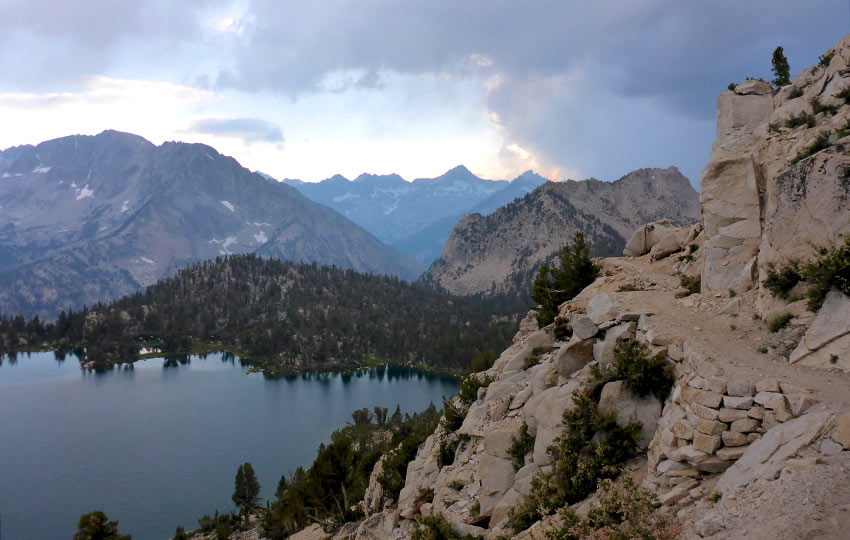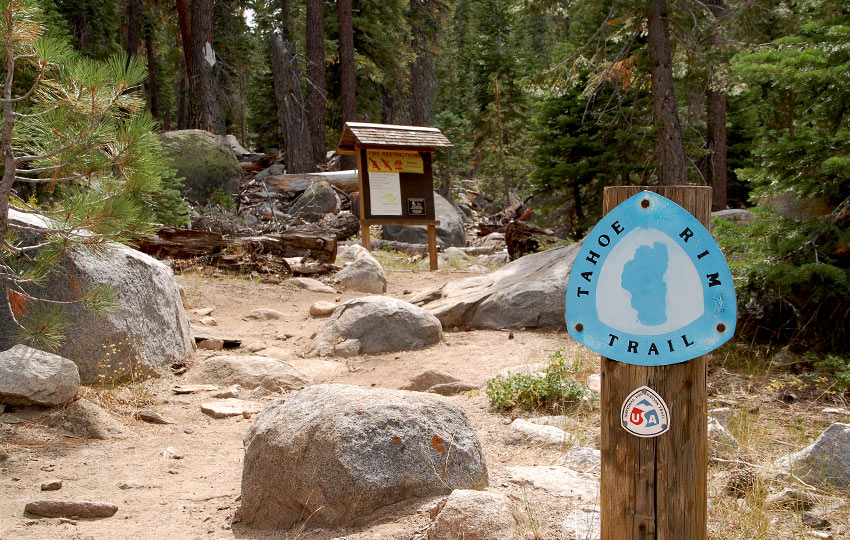
Realizing your dreams of thru-hiking the Tahoe Rim Trail, embarking on an extended backcountry ski tour, or even just going on your first overnight backpacking trip can be a daunting task. However, it’s not impossible! In the first part of this Backcountry Trip Planning series I argued the importance of establishing a goal for your backcountry trip.
Here, in Part 2: SMART Goals, I provide you with a logical and effective means to clarify and test your goal.
SMART is an acronym for Specific, Measurable, Achievable, Relevant, and Timely. SMART is a litmus test to determine whether or not your goal falls into the realm of possibility.
Support Tahoe Trail Guide with a financial contribution via PayPal (single contribution) or Patreon (reoccurring contributions). Your support of Tahoe Trail Guide is very much appreciated!

“But Jared, I just can’t get around the use of the word goal, especially when I’m trying to have fun,” said my friend after I described to her this series of articles. “It sounds so down to business. What about the use of the word intention instead?”
Like I told my friend, I cannot control your personal relationship with the word goal. But rest assured it’s not my intention, plan, purpose, mission, commitment, or goal to pull out a set of brass balls and go Alec Baldwin (a la Glengarry Glen Ross) on you.
I completely understand the pitfalls of being too goal-oriented. The biggest being that you reduce every human experience down to a box in which to check. On the other hand, I’m keenly aware of the destination in which the path of (good) intentions leads.
If you’re just going out for a day hike, choosing a SMART Goal is probably overkill. In this situation, feel free to use intention. Just know that, although the two words can be synonymous at times, they are not the same.
Intentions have more to do with your attitude and state of mind than actually accomplishing anything concrete (like a goal). For example, it’s my goal to finish writing this series of articles about backcountry trip planning by such-and-such date. It’s my intention, however, to inspire you to embark on a more rigorous and potentially more hazardous journey than a day hike by showing you some methods you can use to plan and safely prepare for it.
Setting semantics aside, I will continue to use the word goal in these articles because I’m assuming the backcountry trip you want to take involves risk factors greater than what you would find on a simple walk in the woods.
Out of respect for yourself and the terrain you’ll be tackling, you need to devote adequate time, energy, and resources to planning your backcountry trip.
A failure to plan is a plan to fail comes to mind. The relatively small amount of time and effort that goes into choosing a goal and testing it (SMART Goals) is worth the investment.
In 2014 I thru-hiked the Tahoe Rim Trail (TRT) and, ever since, people have been asking me about the experience.
Many people have asked because they, too, are interested in thru-hiking the TRT. Although many of those people are backpackers, I get the impression that most of them don’t necessarily have the experience or knowledge to plan out a trip longer than a few days. Therefore, to keep things practical and relevant I will continue writing this series of articles using the goal of thru-hiking the Tahoe Rim Trail as my example.
I will write this series of articles as if it were the fall or winter and I was planning the trip for the following summer. This is standard practice for many backpackers. That is, to plan a big trip for the following summer in the previous fall or winter.
Unless you’re an experienced backpacker you usually don’t want to wait until a month before your departure to start planning something major. All of life’s commitments and distractions can cause you to overlook crucial details of an operation on short notice.
Not saying that it can’t be done. However, starting in late fall allows you plenty of time to perform thorough research and generate enthusiasm for your trip. And, you don’t have to deal with a fast approaching deadline!

Once You’ve Chosen a Goal, the Next Step is to Test it According to SMART
SPECIFIC – A specific goal is one that has a definitive beginning and end to it, as well as other concrete aspects such as a location, time frame, and requirements.
The more specific you are with your goal, the better chance you have at achieving it.
Another military adage (that is relevant to this part of SMART) is to aim small, miss small. For example, your chance of hitting the bulls-eye is greater if you specifically aim for it rather than just generally aiming toward the target. And, even if you miss the bulls-eye, you’re more likely to get closer to it than if you just pointed at the whole target.
Thru-hiking the Tahoe Rim Trail is definitely specific. The trail is essentially a circle. So, although you can start anywhere on that circle, you’ll eventually reach your starting/ending point.
It would benefit me to clarify in greater detail my goal. For example, better for me to declare that “I will thru-hike the Tahoe Rim Trail in 12 days, between the dates of July 1-12.”
At this stage in planning, however, I might not actually know if these details are reasonable. I might just use placeholders for dates and a duration of time. When I confirm this information through more research I can then add it to my goal.
MEASURABLE – A measurable goal is one that has quantifiable elements to it.
For lack of a more inspired interpretation of this part of SMART, this is where you would be putting checks in the boxes. Being able to measure your progress while working toward your goal is imperative. Otherwise, how will you know where you stand in relation to where you started and where you plan to end?
The goal of thru-hiking the Tahoe Rim Trail is easy to measure.
Either you’re hiking the miles each day or you’re not. If you’re not making the miles according to your plan, you should at least know where you are on the map. Then you could possibly make up those lost miles on subsequent days. This, too, is a standard practice of many backpackers.
That flexibility wouldn’t be possible if you weren’t measuring your progress.
ACHIEVABLE – An achievable goal is one that lies within your realm of possibilities.
I understand that you can’t truly know unless you do. However, backpacking in general does not require superhuman strength or stamina. It does not require exotic materials or gear, or a lot of money.
As far as the Tahoe Rim Trail goes, other than adhering to Leave No Trace principles and some unique considerations while backpacking in the Lake Tahoe Basin, there are no real restrictions that would prevent you from hiking.
Numerous people of various ages and abilities complete the whole trail each year. So, if you’re relatively healthy, have access to backpacking gear, and can afford to take the time off necessary to complete it, thru-hiking the Tahoe Rim Trail is definitely achievable.
RELEVANT – A relevant goal is one that’s in line with who you are and where your passions and interests lie.
It’s true that our passions and interests change over time, and sometimes we just want to try things for the sake of the experience. This is what makes relevancy the most subjective criteria of SMART Goals, yet probably the most important.
Why do I say this?
Well, your goal could actually meet all of the other criteria. However, if it was abstract and had little to do with who you are or what you want out of life, what would be the point of investing your time, energy, and resources into achieving it?
Sure, it could be just for the experience. But to truly experience a thing means to surrender to it.
An extended backcountry excursion requires a level of commitment and devotion far beyond that of the activities on most peoples’ bucket list. Be sure this is something you truly want to do. I say this because you’re in for a world of suffering if you’re not mentally prepared.
Even if you are committed, that doesn’t mean it won’t still hurt.
Is thru-hiking the Tahoe Rim Trail a relevant goal?
Only you can answer that but, for me, it was very relevant.
TIMELY – A goal that is timely needs to have a clear end date or time in which it will be completed.
One day, someday, eventually … does not meet that criteria.
I would also argue that a timely goal will be one that affords you adequate time to prepare for and complete.
Lastly, for an extended backpacking trip in the Sierra Nevada Mountains, for example, I would say that a timely goal is going to be directly tied to the weather and season in which you hope to travel.
Thru-hiking the Tahoe Rim Trail next July is timely. It affords me many months to research, gather the appropriate gear, and prepare for the experience.
Also, through the initial research that I’ve conducted to determine if this is a SMART Goal, I’ve discovered that July is a favorable month for backpacking at Lake Tahoe.

Using SMART Goals may be superfluous to your planning process if you’ve already determined that, no matter what, you are going to achieve your goal. I still recommend, though, that you put your goal to this test. If anything, it will help clarify what you hope to achieve.
Going into the backcountry for any extended period of time is not something to be taken lightly.
I’m not saying in any way, shape, or form that having a SMART Goal is going to prevent catastrophic injury or death. However, you owe it to yourself to plan your adventure as tight as possible in order to mitigate the risk factors inherent in your endeavor.
By the way, the friend with whom I spoke about earlier in this article spent years working in DC politics. And, she basically traveled the world confronting dictators about their country’s violations of human rights. Her concerns about my word choice stemmed from being immersed in a career where everything needed to be quantifiable. I’m confident she’ll get a good laugh at this mention of our conversation. And, I do agree, that she shares similar sentiments with many other people about the use of the word “goal” in this context.
But guess what?
This type of cerebral analysis and discussion of backcountry philosophy gets me excited. There’s a lot of juice in these topics because they ultimately extend beyond the great outdoors and have broader applications to (and implications in) our lives.
Planning Your Backcountry Trip Core Series of Articles:
- The Importance of Establishing a Goal for Your Backcountry Trip
- SMART Goals and Your Backcountry Trip
- The Decision-Making Process and Your Backcountry Trip
- Gathering Information for Your Backcountry Trip
- Evaluating Information and Choosing the Best Option for Your Backcountry Trip
- Planning and Preparing for Your Backcountry Trip
- Executing Your Backcountry Trip Plan
- Returning Home and Post-Backcountry Trip Analysis
I found this article to be very informative; in that, using the SMART principle is a functional method for laying out a pathway to all things in life, including outdoor adventures. Your article also reminded me of our training in the military-we never did anything without a precise plan in place; no matter the size of the operation or exercise.
Thanks for the feedback! Not that I try to turn my outdoor experiences into military campaigns, but depending on the circumstances and intensity of the adventure it can become that way. And without having a plan in mind it’s easy to find yourself in a difficult and potential serious situation. Thanks again.